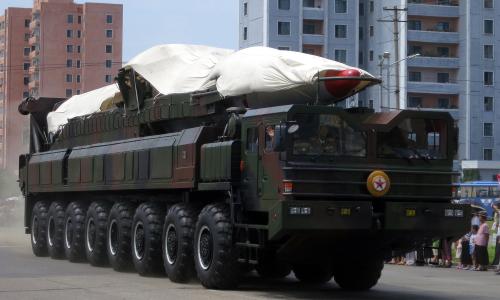The ballistic missile defense system that the United States will deploy later this year will have no demonstrated defensive capability and will be ineffective against a real attack by long-range ballistic missiles. The administration's claims that the system will be reliable and highly effective are irresponsible exaggerations. There is no technical justification for deployment of the system, nor are there sound reasons to procure and deploy additional interceptors.
The Missile Defense Agency should halt its deployment of the Block 2004 GMD system, and Congress should require that the system undergo operationally realistic testing before it is deployed.
On December 17, 2002, President Bush announced that he had directed the Secretary of Defense to begin fielding a ground-based missile defense that would achieve initial operational capabilities in 2004. The system is intended to defend the United States initially against attacks by long-range ballistic missiles North Korea might deploy in the future.
The general operating principles and many of the key components of the ground-based midcourse defense (GMD) system are based on technology developed under the Clinton administration's national missile defense (NMD) program. The GMD system will use ground-based interceptor missiles to launch "kill vehicles" that are intended to destroy their targets by colliding with them in the midcourse of their trajectory, outside Earth's atmosphere. The system will use ground- and sea-based radars to track the warheads and other objects released by attacking missiles, and the kill vehicles will use infrared sensors to home on their targets.
The Bush administration plans to deploy its missile defense systems in two-year blocks. The first, Block 2004, covers the years 2004 and 2005. It is the only block for which detailed information on planned deployments is publicly available, although some general information is available for Block 2006 and beyond. This report focuses on the Block 2004 GMD system.
The Missile Defense Agency (MDA) has been planning to make this system operational by September 30, 2004, with an initial deployment of 10 interceptors at Fort Greely, Alaska, and Vandenberg Air Force Base, California. More recently, the MDA has stated that the system could be operational as early as July 2004, when the first interceptor is deployed in its silo, but that only "several" interceptors would be deployed by the end of September. Current plans are to deploy a total of 20 interceptors at these two sites by the end of 2005, and Congress has already appropriated funds for these interceptors. However, the administration's fiscal year (FY) 2005 budget includes funds to procure and deploy an additional 20 interceptors.
This report analyzes the defensive capabilities of the Block 2004 GMD system as it will initially be deployed and as it is planned to evolve through 2005. To do so, we examine the GMD test program in detail and assess what it has demonstrated about the capability of the system and its individual components. We also analyze the theoretical technical capabilities of the key system components—the radars and the kill vehicle—to determine how they would function in a hypothetical ballistic missile attack by North Korea. We ultimately assess the capability of the defense to defend Hawaii, Alaska, and the west coast of the United States from North Korean attacks. (The administration has stated that the system is also intended to defend against attacks from the Middle East, but this is irrelevant since no nations there could deploy a long-range missile by 2005. Moreover, the radars available to the GMD system are oriented in the wrong direction for attacks coming from the Middle East and look instead toward Russia and China. The MDA has not begun to upgrade the one radar oriented in the right direction, and it is unlikely to be available until the end of Block 2004, if then.)
Although the Pentagon has not publicly issued any detailed assessments of the defensive capability of the system it will deploy, several officials have made statements in congressional testimony indicating that the system will be highly effective. We discuss the assumptions underlying these statements and provide a critique of these assessments. We then discuss the policy implications of the Pentagon overestimating the defensive capability of the deployed GMD system.
We also assess the Defense Department's assertions that the deployment date is "event driven" rather than "schedule driven," i.e., that the date for deploying the system and making it operational depends on events in the development and testing program and not on external factors.
Finally, we recommend changes to the current and future U.S. program to develop defenses against long-range ballistic missiles.



